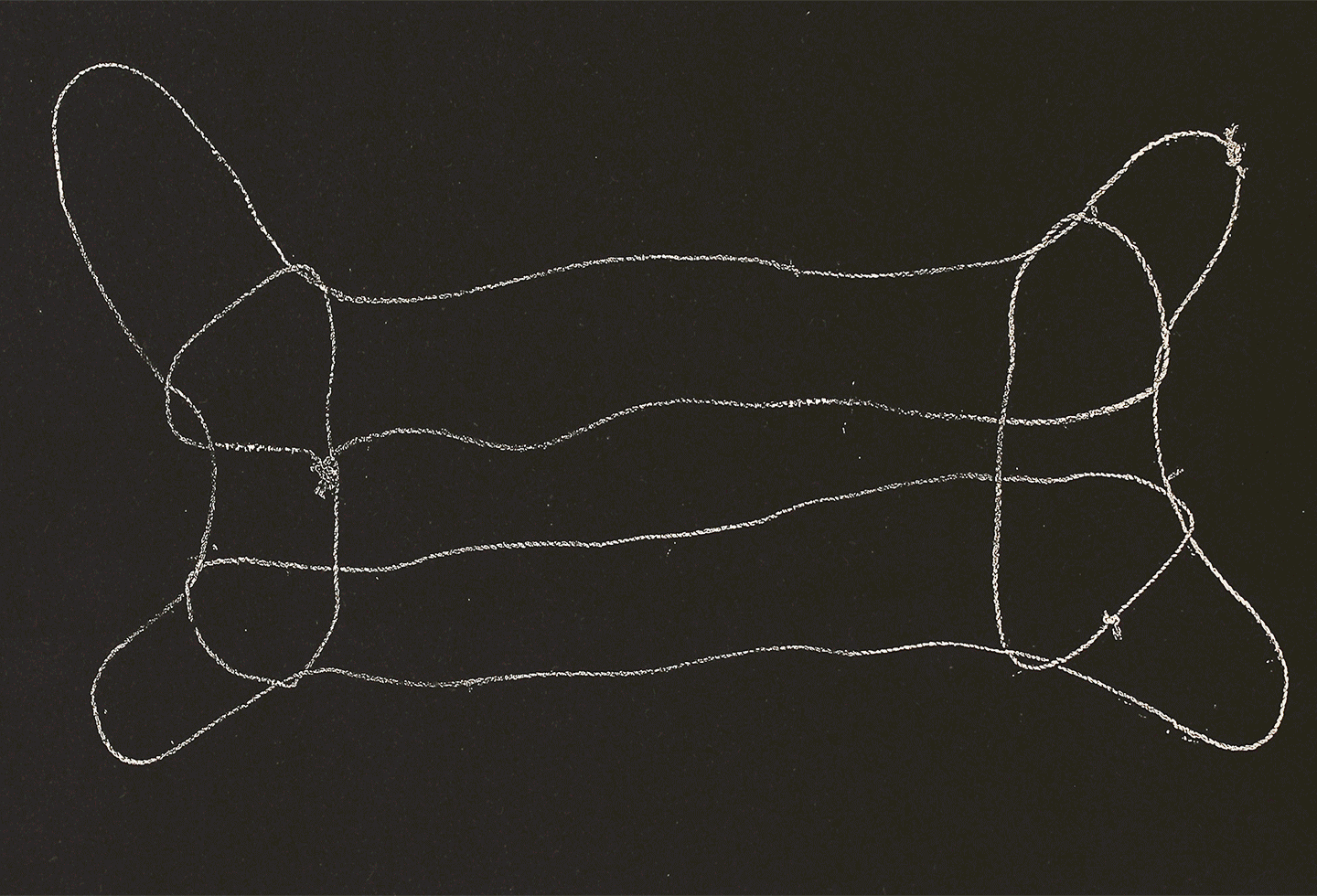November 20, 2024–March 9, 2025
Paul Sacher-Anlage 1
4058 Basel
Switzerland
Hours: Tuesday–Sunday 11am–6pm,
Thursday 11am–9pm
tinguelybasel.infos@roche.com
Stretched between eight fingers and two thumbs, sometimes between teeth and toes, loops of string make shapes. String figures can do many things: they tell stories, they pass the time, they make the unsayable showable, they connect people. As one of humanity’s oldest cultural practices, they have inspired artists, anthropologists, and theorists. String figures have been studied as an aesthetic practice, collected as artifacts, and considered as a non-Western way of thinking. The exhibition juxtaposes historical and contemporary pieces of art with objects from ethnographic collections in order to re:search, re:define and re:signify the past and present of string figure practices.
In anthropology, string figures were long regarded a universal game. As a body practice that can be found in many places of the world, it fed the epistemological fantasies of a universal cultural comparison throughout the 20th century. As early as 1888, Franz Boas described the string figures of the Kwakiutl. Subsequently, European-American (often female) ethnologists ‘collected’ string figures, mounted them on cardboard or made drawings, photographs and films. String figures pinned to cardboard or wood reveal the logics of collecting, ownership, uprooting and systematization along geographical and sometimes racial categories that dominate ethnological collections. Whereas, performed string figures tell of the weaving of relations between people, and between Indigenous culture and anthropology. They can be an expression “of earthhood, of communalhood, of ancestralhood.” (Vázquez)
In avant-garde art, a multitude of references to string figures can be found. Artists were fascinated by their aesthetics, by their relationality, and by the fact that string figures subvert traditional distinctions (such as medium/form or sign/signifier). The history of museum art dealing with string figures includes the names of frequently exhibited, genre- and school-forming, male, white, metropolitan artists such as Marcel Duchamp and Andy Warhol. Alongside them, however, are the names of fringe, female or Indigenous artists who have worked intensively with the ambiguity, ephemerality and/or historical complexity of string figures, such as Harry Smith, Maya Deren and Maureen Lander.
At the intersection of art and theory, string figures have gained prominence in recent years: Donna Haraway promotes string figures as a method of interdisciplinary and interspecies thinking and collaboration. Unlike the technicist metaphor of the network, Haraway’s string figures provide a playful, process-oriented, embodied way of thinking, emphasizing responsibility. Many artists have taken up Haraway’s sf method and used it in their work.
The exhibition brings together people and positions from different regions of the world, creating a string game between Basel, Yirrkala, São Paulo, Anchorage, and Tarawa. By doing so, String Figures. A Research Exhibition provides a space for the celebration of the beauty, playfulness and complexity of a proud cultural practice.
Curated by Mario Schulze and Sarine Waltenspül, co-curator Andres Pardey.
With works by: Jan Bachmann, Edgar Calel and Maju Vicentin, Toby Christian, Maya Deren, Marcel Duchamp, Piet Esch, Moritz Greiner-Petter, Donna Haraway, Maureen Lander, Meyakarraŋgi Marika, Isabel McLeish, Caroline Monnet, Wanharrawurr #2 Munuggurr, Nasser Mufti, David Ket’acik Nicolai, Christoph Oeschger, Mario Schulze and Sarine Waltenspül, Harry Smith, Siena Miḻkiḻa Stubbs, Katrien Vermeire, Dhukumul Wanambi, Andy Warhol, Mulkuṉ Wirrpanda.
In collaboration with: Buku-Larrnggay Mulka Center Yirrkala, Harry Smith Archives, Te Umanibong/Culture and Museum Department Kiribati, Point de Vue Basel, Ethnologisches Museum Berlin, International String Figures Association, Philip Noble, Rufus Cohen, Dunia Lingner and Ruth Altenbach, Ethnographic Museum Zurich, Department of Media Studies University of Basel.
Research for this exhibition was carried out as part of the Swiss National Science Foundation project “Visualpedia. ‘Atlas Encyclopaedia Cinematographica’ and the Visual Science and Technology Studies”, University of Lucerne.
The exhibition is accompanied by a catalogue/anthology String Figures. A Cultural Practice between Art, Anthropology, and Theory published by Diaphanes in February 2025, with articles by Paul Basu, Joshua Bell, Stephan Claassen, Seraina Dür and Jonas Gillmann, Mareile Flitsch, Moritz Greiner-Petter, Diana Guzmán and Andrea Scholz, Rainer Hatoum, Ute Holl, Ines Kleesattel, Moya Lawson, Robyn McKenzie, Nasser Mufti, David Ket’acik Nicolai, Andres Pardey, Adam Piron, Mario Schulze, Rani Singh, Mark Sherman, Ellen Spielmann, Henry Adam Svec, Lynton Talbot, Éric Vandendriessche, Maju Vicentin, and Sarine Waltenspül.



